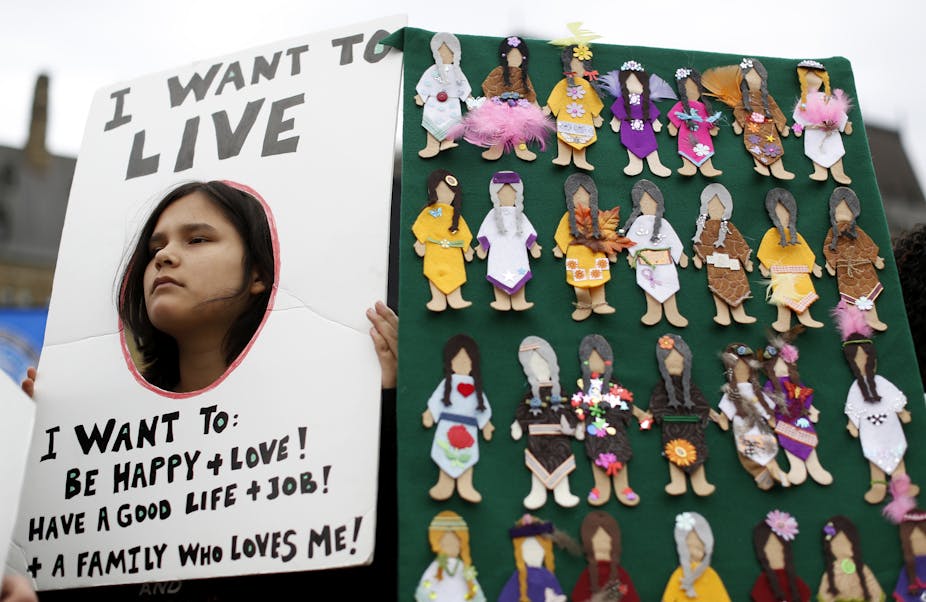In August 2014, Tina Fontaine’s body was pulled from the Red River in Winnipeg Manitoba, stuffed in a garbage bag by her killer. Her disappearance had been reported to the police by child protection workers but city police failed to take her into custody when they came across her at a traffic stop shortly before her death.
Tina’s death was not a tragic isolated event – she is the latest victim of a legacy of violence against Aboriginal women in Canada. The evidence is clear, yet the Canadian government refuses to act.
The Native Women’s Association of Canada and Amnesty International has released a report gathering together details of the disappearance or death of 582 Aboriginal women or girls and identifying trends related to root causes and circumstances. Yet in the same year, the federal government clawed back CAD$5m dedicated to research and support for Aboriginal families of the victims, and reallocated the monies to a general fund for victims of violent crime.
In 2007 Robert Pickton was convicted in the murders of six women (and charged with 27 other murders) in the Downtown Eastside of Vancouver, British Columbia. In the wake of the Pickton trial, the provincial government announced a Missing Women Commission of Inquiry. The final report – entitled “Forsaken” – showed that Aboriginal women were ten times more likely to be murdered in the province than non-Aboriginal women. One-third of Pickton’s victims were Aboriginal.
Throughout the inquiry, Aboriginal women’s organizations were denied funding to speak to the commission, whereas police officers were represented by legal counsel against allegations of failure to protect street involved women, such as those who work as prostitutes or are homeless.
In 2012, a northern Aboriginal community invited Human Rights Watch International to conduct an examination of police practices. The report documented accounts and photographs of girls and women who were bitten by police dogs, punched while handcuffed, and strip-searched by male officers. One woman reported being sexually assaulted by Royal Canadian Mounted Police (RCMP) – Canada’s federal police agency – officers who threatened to kill her if she told anyone.
To date, there has been no formal investigation of the RCMP in these matters; the federal government has stated that the accusations will be investigated only when the women provide written statements identifying the police officers. This is despite the fact that in early 2014, the RCMP reported that between 1980 and 2012, 1,181 Aboriginal girls and women have gone missing or have been murdered in Canada.
The rates of violence against Aboriginal women in Canada (on and off reserve) are staggering. Not surprisingly, given the prevalence of gendered violence in Aboriginal communities, many women reported profound fear of victimization and death. These conditions of endangerment are compounded by severe overcrowding due to housing shortages, as well as by the limited availability of emergency shelters and services for women who seek support or safety from violence.

How is police indifference and brutalization intertwined with the predatorial violence against Aboriginal women? Amnesty International concluded that “despite assurances to the contrary, police in Canada have often failed to provide Aboriginal women with an adequate standard of protection”.
Despite the evidence of inter-generational violence against Aboriginal women and demands of regional governments, the Canadian federal government has refused to call a national inquiry, stating that homicides are properly addressed through law enforcement and the criminal justice system.
Aboriginal women’s organizations have pointed to the economic conditions of reserves that lead women to the streets of urban centers in search of work and education. Some argue political and economic sovereignty for Aboriginal people is necessary to secure women’s empowerment within their own communities.
But the conditions of endangerment that make women unsafe, such as poverty, overcrowding, and the lack of oversight of police agencies are also forms of “racial governance”. In the end, Aboriginal people and their communities are made responsible for their own crises of gendered violence while the government and police look the other way.

